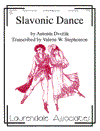Available from Jeffers Handbell Supply at www.handbellworld.com or 800-547-2355
This dance requires a light, lilting quality, even in the strongest sections. The orchestral score reflects this with many strategically placed staccatos. The handbell "RT" (ring touch) is too accented a technique for the staccatos in this work and "TD" (thumb damping) and "Pl" (plucking) are generally too short. Hence, you find the marking "QD" (quick damp, a new term) over many of the staccato sections in this work. It is similar to "RT", but with no accent. Ring close to the shoulder with no arm extension on all of these. The first staccato in each section reqiring this technique will be marked with a "QD" , as well as subsequent phrases. Most of the "QD’s" are in the treble clef, leaving the bass bells with a normal ring. There are fast dynamic changes from forte to piano in this work. Careful attention must be given to those sections. It is always more difficult to control the drop to piano than to ring the fortes. In general, bring the bells closer to the shoulder and use much less arm to achieve the soft contrast. In some instances a "BD" (brush damp) may be necessary, as in meansures 89 and 91. In those measures, the resonance of the bells on the first beat will abolish the ability to play softly on the third beats unless some sound is quickly brushed out. Brush Damp on the second beat. This is an exciting classical work for handbells and I hope you will...Enjoy! VWS
|
Click to View
Sample Pages

|


